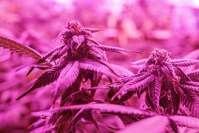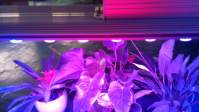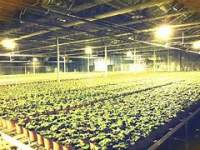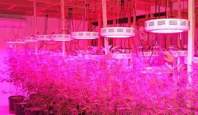As an indoor grower, you will definitely consider which plant growth lamp you choose to fill up your plants with the best light. Light is the key element of plant photosynthesis, the correct choice of plant growth light will greatly promote the growth of plants. Generally choose from these points: initial cost, later cost, spectrum, efficiency and rate of return. Let's compare which of the LED, HPS, and CFL has the advantage?
The operation of LED plant lights is much more complicated than the old technology: small diodes doped with semiconductor materials are energized with a constant current. By using the optical properties of different materials, we can obtain different colors.
Although the operation seems more complicated, the technology has been able to gain a foothold in the market thanks to its high reliability, excellent efficiency and lower cost. LED plant lights do not contain toxic gases, so the most important thing is the environment.
LED plant lights come in different sizes and wattages, revolutionizing the gardening market by allowing the creation of more and more effective lighting solutions with increasingly complex spectrums.
Some manufacturers of indoor LED plant lights mistake growers for the victims of improper marketing. They sell any color other than red or blue as a color that is useless and unusable for plants. They put forward skeptical graphics, indicating that the green light is completely reflected by the leaves, and that they provide you with the most effective products, but the growers may suffer.
However, LED plant lights have "almost twice the efficiency of traditional high-pressure sodium lamps and CFL bulbs (up to 2.6umol/J), especially full-spectrum LED plant lights. The efficiency of the light source and the lack of infrared make most LED lights hardly dissipate heat. , Which is conducive to controlling the temperature of the growth chamber and reducing the cost of pumping. All of these will ensure that you get a good harvest with less electricity.
The cost is certainly high, but the duration and efficiency of the system will give you more or less time to recover your investment.
Fluorescent lamp (CFL)
CFL fluorescent lamps allow us to replace old incandescent bulbs that generate more heat than light. The operation is conceptually similar to the HPS technology: the bulb consists of a high-pressure glass tube filled with mercury and rare gases and two electrodes that can generate ultraviolet light that is powered by an electronic ballast. Then, the light passes through the phosphor that covers the glass tube and is converted into white light.
These bulbs are also available in various sizes and wattages, and because of their low calorific value, they are widely used for professional and home planting. The spectral quality is acceptable, but the system has many limitations: the emitted light is never too strong to bloom, and the electrical efficiency is lower than that of the HPS system; for the best brands, it is about 1.3umol/j.
CFL bulbs are still very suitable for providing low-power light sources in the early plant and cloning stages, providing easy-to-use low-heat solutions. Plants can also grow in contact with the bulb without being burnt.
These lamps are cheap and have a long service life (approximately 10,000 hours of light). Our system is recommended to growers who need to economically solve plant growth stage problems.
High Pressure Sodium Lamp (HPS)
The high pressure sodium lamp (HPS) is undoubtedly the most popular and extensively tested lamp that can be used in various cultivations. These glass bulbs usually have a wattage of 50 to 1000 watts and contain pressurized gas that is ionized by two electrodes to produce photons.
High-pressure sodium lamps (HPS) produce a significant proportion of ultraviolet and infrared (approximately 20%): these frequencies help to simulate the solar spectrum, but are almost completely converted into heat. This requires a proper extraction system. The grower must be careful not to burn the growing leaves to the light. At the same time, excessive heat generation will also cause additional costs.
On the other hand, the rich green and yellow spectrum allows the light generated by these special lamps to penetrate the leaves, which is difficult to achieve with other systems. So they are usually installed on a fixed height ceiling.
Consumption and cost
The high pressure sodium lamp (HPS) has been around for a long time and works well, so many "loyal" growers will not replace it with other products.
The initial cost of the HPS system with power supply and reflector is not high (a complete set of 600W kit is about 150 euros), but the HPS bulb wears out very quickly, so the intensity will drop after a few months, and there will be a bulb to replace it, and later investment The cost will increase.
We recommend using these systems for growers who occasionally hope to spend less money in the short term but still get satisfactory results, especially those who live in cold regions. Let the excess heat be an advantage rather than a defect.
Yaorong LED plant growth light, the product characteristics of LED light (LED plant growth light) can replace traditional lights 3-5 times the power, saving 80% of the electric energy;
LED is used as the light source. And the life span is up to 50,000 hours;
The ratio of different lights can be specified by the customer. We recommend the ratios (red: blue) 8:1, 7:2 and 7:1:1, red. Provide plants with blue, orange, white and yellow mixed light;
The LED wavelength can be specified by the customer. We recommend using 620-630nm and 640-660nm for red wavelengths and 450-460nm and 460-470nm for blue wavelengths. Red light helps plants germinate and bloom, while blue light helps plants grow. You can choose a more suitable wavelength and color ratio to promote plant growth;
Very suitable for all stages of plant growth lights, they are suitable for indoor gardens, aquatic plants or soil-growing plants;
The area and height of the lamp will change according to different plants and environments, and the technical parameters will also change;
All material rings of the product meet environmental protection requirements and do not contain harmful heavy metals such as mercury;
Imported chip LED with high brightness and high reliability as the light source, with high brightness, wide angle and uniform light;
DC12V low voltage drive, safe to use;
Low power consumption, long life, maintenance-free;
Different plants require different growth conditions, and the wavelength of the light source required to participate in plant photosynthesis and affect germination and flowering will also be different. Therefore, the working wavelength of the product and the ratio of light source components will be very different for different plants. It can be customized according to user requirements, or the user provides relevant information, and we determine the composition of the light source for the user. Generally, red and blue light are the main components, and the ratio of red and blue light ranges from 2:1 to 9:1;
Red light: Promote photosynthesis of chlorophyll A and chlorophyll B, promote the formation of plant stems, stems and roots, leaf bulbs and other plants, and affect flowering and fruit;
Blue light: promote plant photosynthesis, promote green leaf growth, protein synthesis, fruit formation, increase yield and shorten the incubation period;
Customers can choose a more suitable wavelength and color ratio to promote the growth of plants according to the needs of your cultivated crops.






